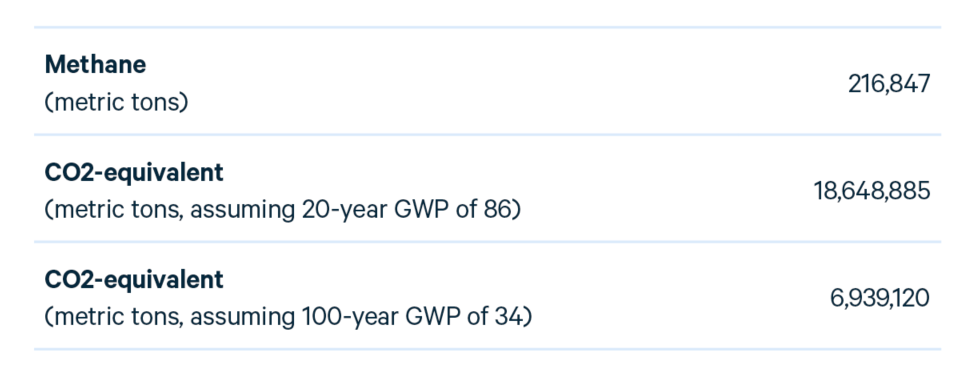Plugging Abandoned Wells: Effects of the Draft Energy Infrastructure Act
This issue brief, part of a three-part series on the Energy Infrastructure Act, details the methane emissions reductions associated with funding to plug abandoned oil wells allocated in the Energy Infrastructure Act.
Introduction
The US EPA estimates that abandoned oil and gas wells in the United States emit roughly 280,000 metric tons of methane each year, though this estimate is uncertain. Per ton, methane’s global warming potential (GWP) is 34 times that of carbon dioxide (CO2) over a 100-year period and 86 times the impact over a 20-year period. Using the 100-year GWP, annual methane emissions from abandoned wells are roughly equivalent to the CO2 emissions emitted by all of the power plants in Massachusetts each year. Plugging abandoned wells presents an opportunity to provide jobs in the oil and gas industry while also reducing methane emissions.
A 2020 analysis by Resources for the Future and Columbia University Center for Global Energy Policy estimated that a significant federal program to plug abandoned oil and gas wells could employ tens of thousands of workers, with as many as 120,000 job years created to plug 500,000 wells. The costs associated with reducing greenhouse gas emissions through a major well plugging program would also fall well within the range of other climate policy options—roughly $67 to $170 per ton of CO2-equivalent greenhouse gas reductions.
Several policy proposals have sought to provide funding to plug these wells and reduce methane emissions while creating new jobs in the oil and gas industry. One such bill is the Energy Infrastructure Act, a new proposal from West Virginia Senator Joe Manchin that earmarks tens of billions of dollars in federal funds towards environment and energy-related initiatives, including $4.7 billion for plugging abandoned oil and gas wells. This issue brief, part of a three-part series on the Energy Infrastructure Act, details the methane emissions reductions associated with this potential spending.
Proposed Actions
Section 6001 of the act provides $4.7 billion in funding to plug abandoned oil and gas wells throughout the United States over a period of 10 years.
Results
Based on recent RFF analysis that finds decommissioning costs of $76,000 per well, this level of funding would support decommissioning just under 62,000 wells, or approximately 6,200 wells per year over 10 years. Based on two recent estimates from RFF and partner institutions, decommissioning 62,000 wells would support between 15,000 and 33,000 job-years.
On average, each well emits around 0.13 metric tons of methane per year (though, as noted above, this is an uncertain estimate). Since methane is a more potent greenhouse gas than carbon dioxide, this 0.13 metric tons of methane has the warming equivalent of 11 tons of CO2 using a 20-year GWP, or 4 tons of CO2 using a 100-year GWP. (This disparity is due to the fact that, while methane absorbs more energy than CO2, it stays in the atmosphere for less time, so it causes more warming over a shorter period.)
RFF analysis shows that plugging wells at this rate would cumulatively reduce methane emissions by approximately 217,000 metric tons over 50 years— that’s equivalent to abating 18.6 million metric tons of CO2 using a 20-year GWP, or about 6.9 million metric tons of CO2 using a 100-year GWP. Figure 1 shows that emissions abatement grows over time—even after all the wells have been decommissioned—as the wells would have continued to emit methane for years if left unplugged.
Table 1. Cumulative Emissions Reductions Over 50 Years

Assumptions
This analysis is predicated on a few key assumptions. First, the average cost of plugging each well is assumed to be approximately $76,000. Second, the rate of plugging the wells stays constant over 10 years of funding, at approximately 6,200 wells per year. Third, the discount rate is set at 2 percent, which means that the present-value of the benefits of emissions reductions are valued at 2 percent lower for each additional year
in the future the emissions reductions occur. Fourth, it assumes that well plugs are 100 percent effect for 50 years, with no benefits beyond 50 years.




